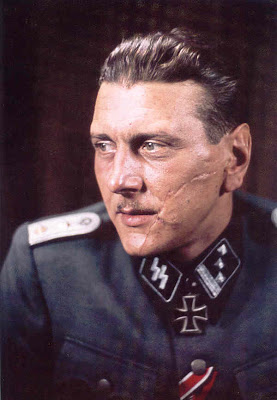Apologies for not posting any interesting original material in the past few weeks, I’ve been busy dealing with the holidays and the celebrations that inevitably pop up at this time of year. Today’s blog post will be about a topic I’ve become fascinated with over the course of the past two years. Have you ever wondered why stereotypical WWI German media characters from WWI always seem to have a large scar on their face? Ever wonder why they always seem to be on the cheek and always are attributed with men of high status such as generals and higher ranking officers?
Well, recently I was able to purchase on eBay an inexpensive photo ($4.99) on eBay that perfectly personifies the image of a young WWI German soldier with a prominent facial scar.

Mensur Scar (New photo to collection)
Was this scar the result of a bad shaving accident? In fact, the answer is exactly the opposite; this left cheek scar is the result of a deliberate action.

Ouch!
After a solid night of internet research, I was able to cobble together an answer regarding the odd number of facial scars associated with late 19th and early 20th century German and Austrian soldiers. The Dueling Scar!
Male (upper class) students who were members of fraternities of major German and Austrian universities during this time were often engaged in academic fencing which at times would, at times, become a duel between competing fraternities. These individualized duels between students eventually became a badge of honor among fraternity members – taking a blow to the face showed courage and was a lasting reminder of the fraternal bond.
Since these boys were often from a higher class, it was no surprise that many eventually became officers during WWI. This act was well know during the time and eventually became banned around the time of the outbreak of the war. The ban was lifted when Adolf Hitler came to power in 1933. Many of the German officers of WWII had these scars given the fact that they were in university prior to WWI.
A fun fact – The majority of scars appear on the left side of the face due to the fact that many fencers were trained in a right-handed style!
Skip ahead to 2:50 to see the duel in action!

Otto Skorzeny with Mensur Scar

German Pilot Eduard Wolfgang Zorer




Cartoon View ca. 1909 (From eBay listing)

Luftwaffe Portrait Photo (from an eBay auction)

















